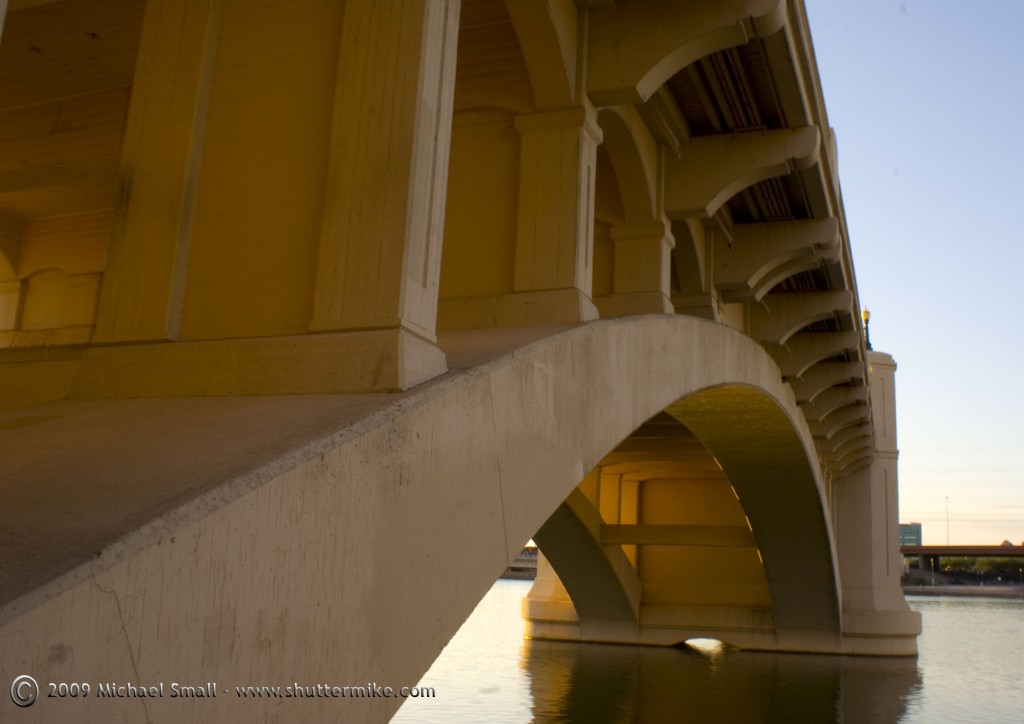If there is one thing that you simply must photograph in Phoenix it is the sunsets. Having said that, as you can well imagine, there are a lot of great spots in and around Phoenix where you can capture some spectacular sunsets. So I have had to narrow my list down to keep things manageable. These may not be the top five spots to photograph a sunset in Phoenix, but I contend that they are among the top. Also, if you want a sunset shot that is a little more than the standard that you see on all the postcards, a few of these spots, when combined with some imagination and creative thinking, could get you that unique shot. So check out when the sun is due to set, grab your camera (and tripod) and head out to any of these spots to capture your next great sunset photograph.
 South Mountain encompasses a very large area. It has hiking trails, picnic areas, and numerous other facilities available. But if you want the perfect sunset spot you need to get yourself to the summit. This is a very well known vista, so head up early to stake out a good spot, especially if you are going on a weekend. Exit I-10 on Baseline Rd and head west to Central Ave. Turn South on Central and take it to the entrance of the park. Once in the park, follow Telegraph Pass Rd up to the summit. Park the car and set up your camera in area that overlooks downtown Phoenix. You will have a perfect vantage point to view the entire valley out to the west and the setting sun. If you have a wide angle lens try getting the city with the sunset in the background.
South Mountain encompasses a very large area. It has hiking trails, picnic areas, and numerous other facilities available. But if you want the perfect sunset spot you need to get yourself to the summit. This is a very well known vista, so head up early to stake out a good spot, especially if you are going on a weekend. Exit I-10 on Baseline Rd and head west to Central Ave. Turn South on Central and take it to the entrance of the park. Once in the park, follow Telegraph Pass Rd up to the summit. Park the car and set up your camera in area that overlooks downtown Phoenix. You will have a perfect vantage point to view the entire valley out to the west and the setting sun. If you have a wide angle lens try getting the city with the sunset in the background.
The summit is the quintessential Phoenix sunset. But if you want something a little different that might be a little harder to get and require a little more creativity drive past the road to the summit parking lot and take Buena Vista Rd to S. TV Rd. You will understand why it is called TV road soon enough. Take the road until it dead ends at a parking lot. This vantage point does not have a clear view of the western setting sun. But it does offer several opportunities for a “non-traditional” sunset photograph. Try capturing the mountain top filled with TV and cell phone antennas with the glow of the setting sun behind them.
 If you have been to Phoenix you are probably familiar with Camelback Mountain. It is the one in the middle of it all and if you squint a bit and use your imagination it does look like a camel. You can approach the camel from the rear or from the head and find great sunset photography spots. Unlike South Mountain which you can drive to, a car will only get you so far with Camelback. Be prepared to hike a bit for these shots, especially if coming up from the rear. (Note that hiking in Arizona requires some forethought and preparation – DO NOT FORGET THE WATER).
If you have been to Phoenix you are probably familiar with Camelback Mountain. It is the one in the middle of it all and if you squint a bit and use your imagination it does look like a camel. You can approach the camel from the rear or from the head and find great sunset photography spots. Unlike South Mountain which you can drive to, a car will only get you so far with Camelback. Be prepared to hike a bit for these shots, especially if coming up from the rear. (Note that hiking in Arizona requires some forethought and preparation – DO NOT FORGET THE WATER).
For the rear (or eastern) route you will find parking off Invergordon Rd between Camelback Rd and McDonald Rd (near the Phoenician Resort). If coming up the front, park near McDonald and Tatum. Keep in mind parking can be limited depending on when you go. Depending on your hiking skills and speed it can take an hour or more to reach a vantage point where you can capture a great shot. So plan your timing accordingly and make sure you can make it up before the sun sets. Also keep in mind you then have to hike back down. So don’t wait too long after sunset to start heading back down as this could be a difficult feat in the dark. But this one is worth the extra effort.
As long as you are in hiking mode, consider Piestewa Peak (formerly known as Squaw Peak) for another location to catch the setting sun on film (or digital sensor). The peak rises above Phoenix at about 2,600 feet. So as you can imagine, you are going to get some great views. Depending on how much of a challenge you are up for (and how in shape you are) you have two trail options to get up to the views. The Summit Trail is just over a mile and falls into the “challenging” category. But you are going to get views along the whole route and once you make it to the summit you will very glad you did. City views galore! Option two is the Circumference Trail. It is a much longer hike, about 3.75 miles, but the ascent up the peak is much more gradual. Plus you still get the views along the way and at your destination. Piestewa is the place you want to go if after getting your sunset shots you want to try your hand at some city lights photography. The only drawback is you are going to have to haul your tripod up (and back down) the mountain. But I think you will find it well worth the extra effort.
To get to Piestewa Peak head up the 51 freeway and exit at Glendale Rd. Take Glendale (it will change names and become Lincoln) east until you hit Squaw Peak Drive. Parking and trail heads will be at the end of this road after passing through some residential areas.
Up until this location I have taken you above the city for three mountain top sunset photography opportunities. Steel Indian School Park offers an option you may not have thought of before. Located off Indian School Rd between Central Ave and 7th St. the park is a vast urban oasis (don’t get it confused with Indian School Park in Scottsdale). Offering grassy hills, a lake, diverse landscapes and historic buildings you may need to spend some time before the sun sets to scout out the location and settings you want to capture with the sunset. Consider getting the nearby skyscrapers in your viewfinder and playing with the sun reflecting in the glass facades. The lake area can also be ideal when it comes to the setting sun. Reflections on the water can make for some beautiful photographs. No strenuous hiking required with Steele Indian School Park, but you might have to strain the brain a bit to get your creativity flowing. The opportunities abound here if you take some time to scope things out.
 If you have read any of my blog in the past you will know that I have an affinity for the Phoenix Desert Botanical Garden. It is great for early morning photography, desert vegetation photography, and wildlife photography so it stands to reason you are going to be all set for some great sunset photography as well. This is the only location on the list that has a fee associated with it, but still well worth spending a little cash for a great desert sunset photograph. To get there exit the 202 freeway at the 52nd St/ Van Buren exit and head east. Signage will direct you to the garden entrance off Galvin Parkway.
If you have read any of my blog in the past you will know that I have an affinity for the Phoenix Desert Botanical Garden. It is great for early morning photography, desert vegetation photography, and wildlife photography so it stands to reason you are going to be all set for some great sunset photography as well. This is the only location on the list that has a fee associated with it, but still well worth spending a little cash for a great desert sunset photograph. To get there exit the 202 freeway at the 52nd St/ Van Buren exit and head east. Signage will direct you to the garden entrance off Galvin Parkway.
Get to the garden early to both enjoy the beautifully designed acres of desert landscaping and to scout for an ideal vantage point for your sunset photograph. The cool thing is that there are so many possibilities and you can create some gorgeous art by taking some time and finding the perfect vista to point your camera to. Be sure to consider using the vegetation and structures as foreground or background for your photograph. The red rocks of nearby Papago Park (a potential 6th spot?) are another element you will definitely want to play with in your shots.
There you have it – five top spots in the Phoenix area for sunset photography and no more excuses for not getting out there and taking your best sunset photograph. Good luck!
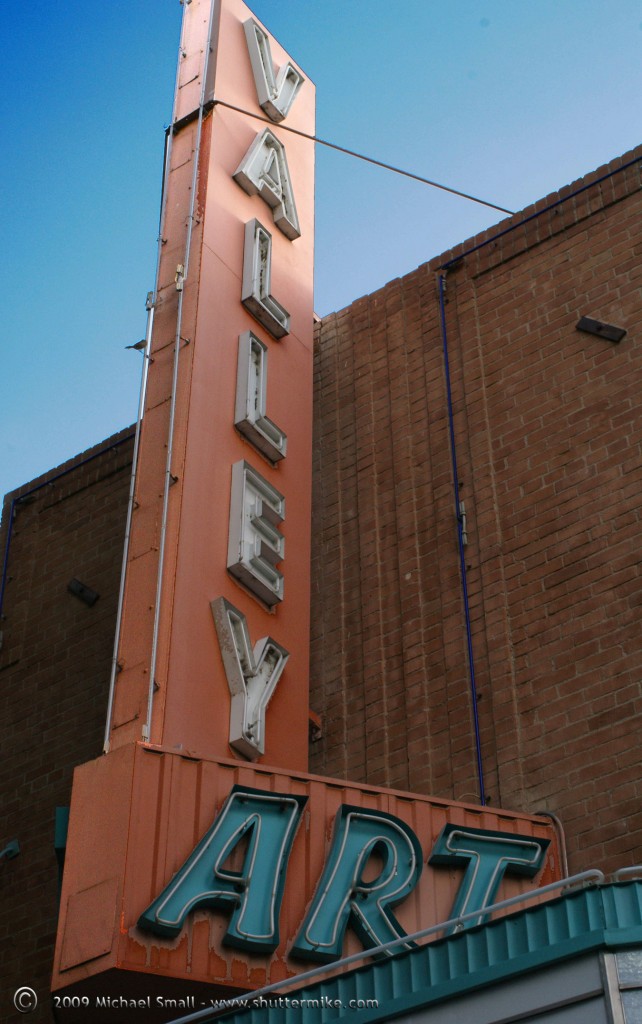
Valley Art Theater on Mill Ave. – Tempe, AZ
f/16 – ISO 160 – Focal Length 40 mm
Now part of the Harkins chain, the Valley Art Theater opened in 1940 as the College Theater (named due to its close proximity to Arizona State I presume). It is a rare surviving single screen theater used today for mostly independent and “art” films. I list it as a “sign of things to come” because it is a hint as to a post I have in the works. Stay tuned.
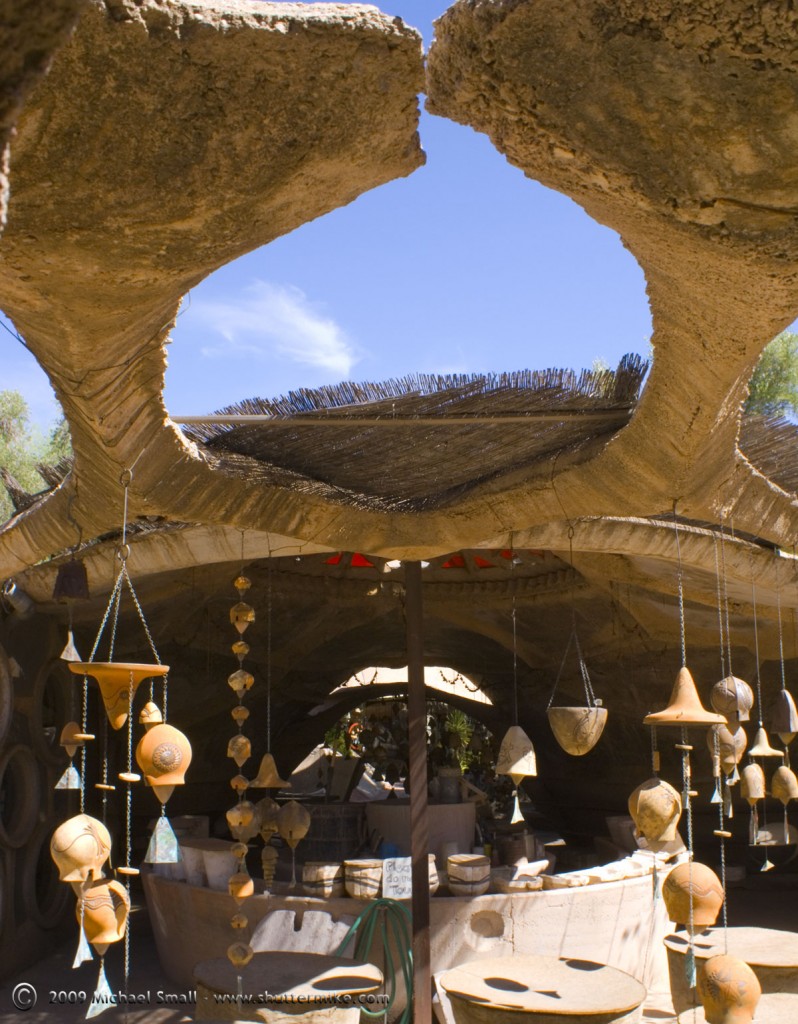
Paolo Soleri’s Cosanti Bell Foundry in Paradise Valley, AZ
In this photo – the ceramic bells and their production area
f/20 – 1/30 sec – ISO 200 – Focal Length 18 mm
One of this weekend’s photo outings was to Paolo Soleri’s Cosanti. This is the foundry where Soleri’s metal and ceramic wind bells are designed, made and sold. The architecture of the buildings is all by Soleri as well and follows his Archology theory of design which is, essentially, a very organic aesthetic. The buildings almost grow from the earth and appear haphazard and to some degree “homemade.” A little further north of Phoenix is Arcosanti, the prototype of Soleri’s urban alternative architecture that he calls Archology – a combination of architecture and ecology. Both Cosanti and Arcosanti are fantastically photographic places – especially if you love architecture and nature, as they combine the two very well.
For my photography a tripod is an essential piece of equipment. My night and long exposure photography cannot be done without one. Therefore I think investing in a good, quality tripod is important. When it comes to tripods you can spend a very wide range of money on one and get a very wide range of quality and functionality. You can spend $30 – $50 on a simple one at someplace like Target or up to $400 on a very advanced model. Before grabbing the cheapest one or investing a large sum in the top of the line there are a few things you should consider.
- Where will you be using it? Indoors or out? Different models maybe better suited for the rugged outdoors while some are ideal for indoors studio use.
- What is your budget? Get the best one you can afford, but be reasonable the more you spend does not equate to the better the photograph you end up with.
- How heavy is your camera with your largest lens? Make sure the tripod you get can support the weight.
After my inexpensive SunPak tripod had succumb to overuse I shopped and asked around for a model that was an upgrade yet under the $200 mark. I wanted something that would last, was rugged enough for outdoor use and could hold my camera and my fantasy lenses that I yet to have.
 I ended up with the Induro AB2 Tripod Kit. Going with a kit is a cost saving way to buy a tripod. Otherwise you need to buy the legs and head as two separate pieces. At about $180, I felt this was a good price for what you get. And what you get for that is:
I ended up with the Induro AB2 Tripod Kit. Going with a kit is a cost saving way to buy a tripod. Otherwise you need to buy the legs and head as two separate pieces. At about $180, I felt this was a good price for what you get. And what you get for that is:
- a 66.5″ tripod when fully extended (28.5 inched when collapsed)
- a ball head
- two bubble levels and a compass built in
- 3 section quick locking legs
- load capacity up to 18.7 lbs – that should hold even the fancy lenses
- And a carrying case to boot
I have been using this tripod for a few months now and have no complaints.
- It is quick and easy to set up and adjust.
- The legs are sturdy and provide even, level footing on all the surfaces I have tried so far.
- The ball head allows for movement in any direction with ease.
- The camera can be mounted and released quickly.
Overall I feel I got my money’s worth in a solid, quality tripod that will last me for years to come. I did not buy the top of the line, but I got something that meets the needs of the photography I do and the camera equipment I own. The bottom line with tripods is that you should not skimp, but it is not necessary to go overboard either. Knowing what will fit your photography style is key and you can easily find something in your budget that you are sure to be happy with as I am with my Induro AB2.
Scottsdale, AZ is in no danger of failing the photogenic test – if there were such a test that is. From downtown to the open desert of North Scottsdale to its countless resorts and golf courses there is always something to photograph. The Scottsdale Daily Photo blog does a great job of capturing the photographic beauty of Scottsdale and is worth checking out. Bonus: the photographer behind the Scottsdale blog also has a travel blog. And she has been just about everywhere. So while you are at it, check out Viva la Voyage.
First, did you know that Arizona had a wine region? It has most everything else, mountains, deserts, canyons, grasslands, major cities, might as well have a wine region too. Arizona’s Verde Valley Wine Trail encompasses four wineries in a very beautiful and very photogenic region of the state, the Verde Valley. The wineries on the trail are the Page Springs Winery, Javelina Leap Winery, Oak Creek Vineyards all in Cornville, AZ and the Alcantara Vineyards in VerdeValley, AZ.
The photo contest is sponsored by the Cottonwood Chamber of Commerce and has a theme of “On the Verde Valley Wine Trail.” Your goal in shooting should be to capture the essence of the Verde Valley wine country. Photographs of the vineyards, the fields, the wine makers, wine tasting and wine connoisseurs are all game for this contest. One thing to note is that you have to be over 21 to enter because what better prize for a winery photo contest than wine!
If you are interested you can learn more about the contest here: www.vvWinetrail.com.
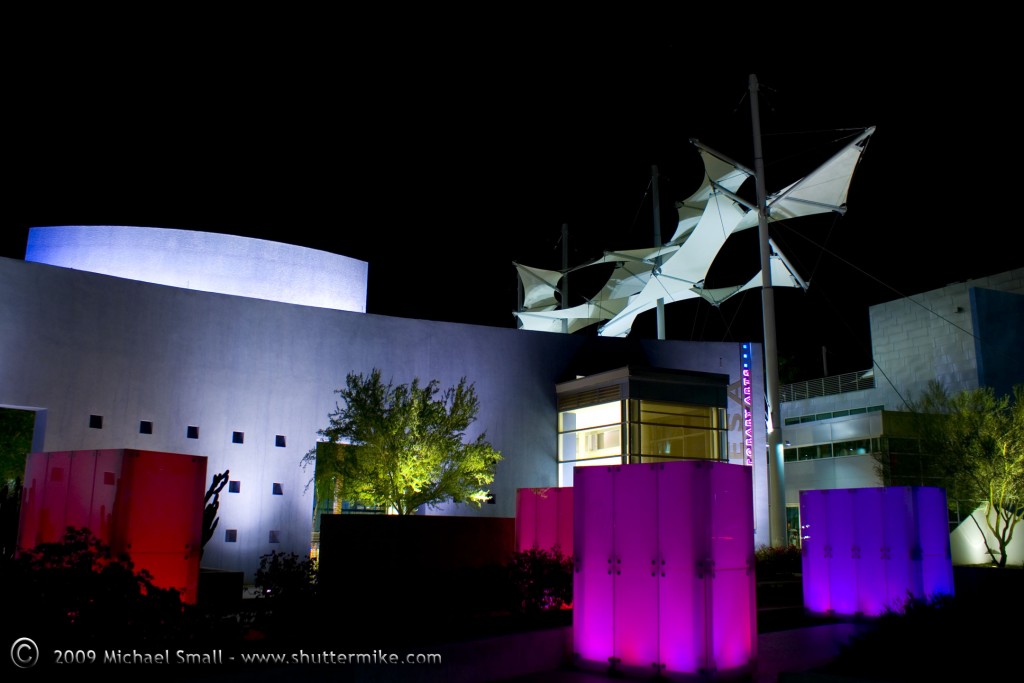 Mesa Arts Center (West Side) – Mesa, AZ
f/3.5 – 1 sec – ISO 80 – Focal Length 18 mm – Shutter Priority
Mesa Arts Center (West Side) – Mesa, AZ
f/3.5 – 1 sec – ISO 80 – Focal Length 18 mm – Shutter Priority
This photograph was taken at about 7:30 pm on September 10th. It is the west side of the Mesa Arts Center looking east. The light boxes rotate through a palette of colors including those shown here as well as greens and yellows.
I shoot most of the time with the RAW/Jpg option so that I get the full effect of the uncompressed RAW image as well as a jpg. For this photograph I did do a little Photoshop post production work on the RAW file. First I changed the white balance to tungsten. This made the colors and the rear lit wall stand out more. Next I increased the color saturation some to also really make the colors of the light boxes pop. Finally, I did an auto adjust on the levels. I don’t usually do much in Photoshop other than some cropping and “blemish” removal, but I think the end result of this photo turned out well.
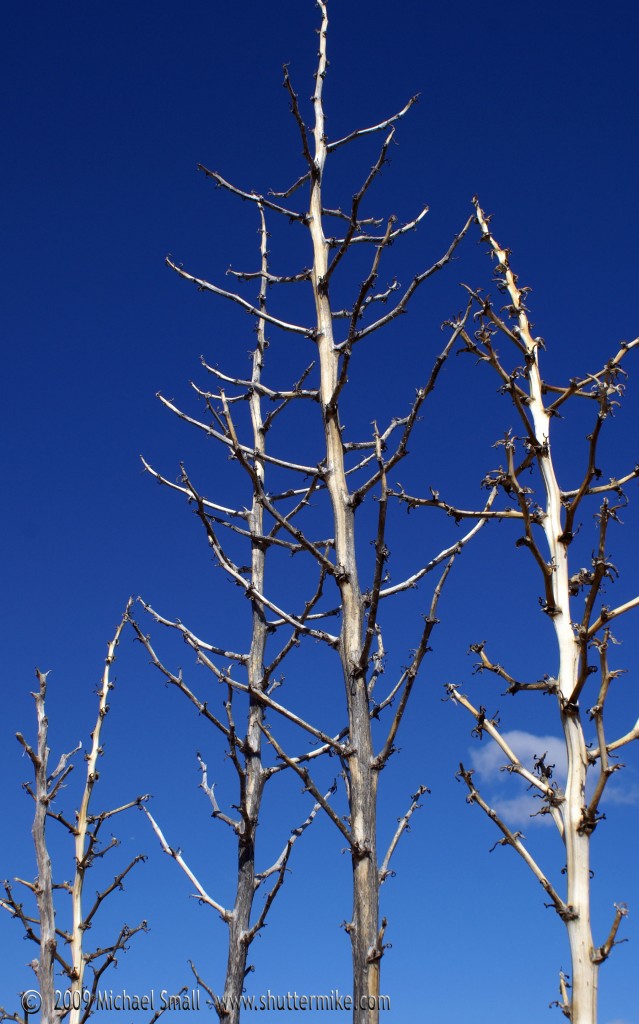
” Just Sticks”
f/10 – 1/320 sec – ISO 100 – Focal Length 26 mm
One of the things I love most about photography is looking beyond the surface. I am not sure if that is seeing with a photographer’s eye. Or just seeing what most people take for granted and walk right past. But it is seeing beauty in ordinary things; noticing angles, patterns, light and perspectives that most people may not see; and stopping to look at the details. This photograph embodies those concepts for me. It is relatively simple, possibly “just sticks” to most. But the patterns, the contrast of colors – gray against the blue tones, and even the overt ordinariness of it struck me.
I called this post an “attempt” at photographing lightning because it was the first time I ever tried to capture one of the frequent summer lightning storms in Arizona. And, although I actually did capture some lightning on my camera’s sensor, I feel that there is a lot of room for improvement.
I won’t give any how-to tips on this particular subject. For one, I have a long way to go before mastering the successful lightning shot and second, there are already some great sources out there on the subject. My favorite source for photography how-to advice, the Digital Photography School, has a great tutorial on How to Photograph Lightning.
I weeded through a lot of shots to pick out these three. These were all taken between 7 and 7:30 pm on September 8th. So just after the official sunset. The camera was set to aperture priority. I did some minor editing in Photoshop to tweak exposure and crop them. But for the most part they are true to how they were shot.
 f/7.0 – 4 sec – ISO 100 – Focal Length 100 mm
f/7.0 – 4 sec – ISO 100 – Focal Length 100 mm

f/8.0 – 4 sec – ISO 100 – Focal Length 100 mm

f/7.0 – 4 sec – ISO 100 – Focal Length 130 mm
 South Mountain encompasses a very large area. It has hiking trails, picnic areas, and numerous other facilities available. But if you want the perfect sunset spot you need to get yourself to the summit. This is a very well known vista, so head up early to stake out a good spot, especially if you are going on a weekend. Exit I-10 on Baseline Rd and head west to Central Ave. Turn South on Central and take it to the entrance of the park. Once in the park, follow Telegraph Pass Rd up to the summit. Park the car and set up your camera in area that overlooks downtown Phoenix. You will have a perfect vantage point to view the entire valley out to the west and the setting sun. If you have a wide angle lens try getting the city with the sunset in the background.
South Mountain encompasses a very large area. It has hiking trails, picnic areas, and numerous other facilities available. But if you want the perfect sunset spot you need to get yourself to the summit. This is a very well known vista, so head up early to stake out a good spot, especially if you are going on a weekend. Exit I-10 on Baseline Rd and head west to Central Ave. Turn South on Central and take it to the entrance of the park. Once in the park, follow Telegraph Pass Rd up to the summit. Park the car and set up your camera in area that overlooks downtown Phoenix. You will have a perfect vantage point to view the entire valley out to the west and the setting sun. If you have a wide angle lens try getting the city with the sunset in the background. If you have been to Phoenix you are probably familiar with Camelback Mountain. It is the one in the middle of it all and if you squint a bit and use your imagination it does look like a camel. You can approach the camel from the rear or from the head and find great sunset photography spots. Unlike South Mountain which you can drive to, a car will only get you so far with Camelback. Be prepared to hike a bit for these shots, especially if coming up from the rear. (Note that hiking in Arizona requires some forethought and preparation – DO NOT FORGET THE WATER).
If you have been to Phoenix you are probably familiar with Camelback Mountain. It is the one in the middle of it all and if you squint a bit and use your imagination it does look like a camel. You can approach the camel from the rear or from the head and find great sunset photography spots. Unlike South Mountain which you can drive to, a car will only get you so far with Camelback. Be prepared to hike a bit for these shots, especially if coming up from the rear. (Note that hiking in Arizona requires some forethought and preparation – DO NOT FORGET THE WATER). If you have read any of my blog in the past you will know that I have an affinity for the Phoenix Desert Botanical Garden. It is great for early morning photography, desert vegetation photography, and wildlife photography so it stands to reason you are going to be all set for some great sunset photography as well. This is the only location on the list that has a fee associated with it, but still well worth spending a little cash for a great desert sunset photograph. To get there exit the 202 freeway at the 52nd St/ Van Buren exit and head east. Signage will direct you to the garden entrance off Galvin Parkway.
If you have read any of my blog in the past you will know that I have an affinity for the Phoenix Desert Botanical Garden. It is great for early morning photography, desert vegetation photography, and wildlife photography so it stands to reason you are going to be all set for some great sunset photography as well. This is the only location on the list that has a fee associated with it, but still well worth spending a little cash for a great desert sunset photograph. To get there exit the 202 freeway at the 52nd St/ Van Buren exit and head east. Signage will direct you to the garden entrance off Galvin Parkway.

